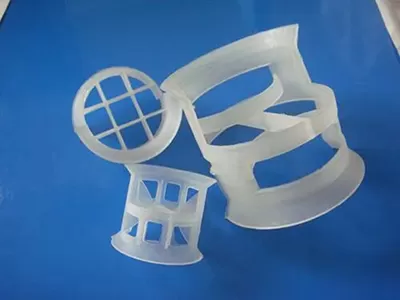Plastic Conjugated Ring is a versatile industrial packing designed for gas-liquid mass transfer, absorption, and separation processes. It features a conjugated ring structure made of high-performance plastic materials, offering excellent chemical resistance and cost-effectiveness for diverse industrial applications. The structure consists of interconnected double or multi-rings with staggered openings, forming a three-dimensional channel system that enhances gas-liquid contact and mixing efficiency, making it suitable for medium-temperature, low-pressure, and corrosive industrial towers.

The Plastic Conjugated Ring typically adopts a double-ring conjugated design with evenly distributed notches and holes on the ring walls. This design ensures smooth flow of gas and liquid while increasing the specific surface area for mass transfer. Common materials include polypropylene (PP), polyvinyl chloride (PVC), and polyvinylidene fluoride (PVDF). PP variants provide good temperature resistance and mechanical flexibility, PVC offers strong resistance to acids and alkalis, and PVDF excels in high-temperature and chemical corrosion resistance, adapting to different operational environments.

Performance Advantages
- High Mass Transfer Efficiency: The conjugated ring structure with staggered openings creates turbulent flow, prolonging gas-liquid contact time and increasing mass transfer efficiency. It maintains stable performance in medium-load processes, meeting the requirements of general industrial separation and absorption.
- Excellent Chemical Resistance: Plastic materials resist corrosion from non-oxidizing acids, weak alkalis, and most organic solvents. PVC and PVDF variants can withstand harsh chemical environments, ensuring long-term stability in chemical wastewater treatment and solvent recovery systems.
- Lightweight and Low Tower Load: With a density of 0.9-1.7 g/cm³, the packing is much lighter than metal counterparts, reducing the structural load on towers and lowering construction and reinforcement costs for equipment.
- Low Pressure Drop and Energy Saving: The optimized channel design minimizes gas flow resistance, resulting in low system pressure drop. This reduces energy consumption for fans or pumps by 15-20% compared to some traditional packings, saving operational costs.
- Cost-Effective and Easy Maintenance: Plastic materials and mature injection molding processes reduce production costs. The smooth surface reduces impurity adhesion, lowering cleaning frequency and maintenance workload, which is economical for large-scale applications.
Application Fields
- Chemical Processing: Widely used in medium-temperature absorption towers, solvent recovery towers, and acid-base neutralization towers for processes such as organic solvent separation, chemical intermediate purification, and weak acid treatment.
- Environmental Protection Engineering: Applied in industrial waste gas absorption towers (VOCs treatment, ammonia gas absorption), wastewater stripping towers, and biological filtration towers, enhancing pollutant removal efficiency in low-to-medium concentration systems.
- Water Treatment Systems: Utilized in water softening towers, deaerators, and ozone contact towers for municipal and industrial wastewater treatment, improving water purification efficiency and ensuring stable water quality.
- Light Industry and Daily Chemicals: Used in distillation, extraction, and purification processes of cosmetics raw materials, food additives, and detergent ingredients, leveraging its low contamination risk and easy cleaning features.
Product Parameter Table
Type | Material | Diameter (mm) | Specific Surface Area (m²/m³) | Void Fraction (%) | Pressure Drop (Pa/m) | Max Operating Temperature (°C) |
Plastic Conjugated Ring | PP | 25 | 160 - 190 | 88 - 92 | 80 - 110 | 100 |
Plastic Conjugated Ring | PVC | 50 | 110 - 140 | 85 - 89 | 70 - 90 | 60 |
Plastic Conjugated Ring | PVDF | 38 | 130 - 160 | 86 - 90 | 75 - 100 | 150 |
Plastic Conjugated Ring | PP | 76 | 70 - 90 | 90 - 94 | 60 - 80 | 100 |


.jpg)
.jpg)
.jpg)
.jpg)
.jpg)
.jpg)
.jpg)
.jpg)
.jpg)
.jpg)